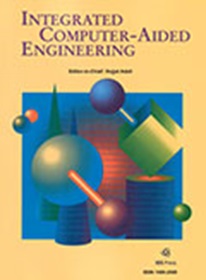面向机器人运动规划的膜平行快速探索随机树算法
IF 5.8
2区 计算机科学
Q1 COMPUTER SCIENCE, ARTIFICIAL INTELLIGENCE
引用次数: 44
摘要
近年来,基于增量采样的运动规划算法被广泛应用于求解高维构形空间中的机器人运动规划问题。特别是,快速探索随机树(RRT)算法和它的渐进最优对应称为RRT*是在现实生活中使用的流行算法,由于其理想的性质。这样的算法本质上是迭代的,但是某些模块(如冲突检查过程)可以并行化,相对于顺序实现提供显著的加速。在本文中,RRT和RRT*算法已经适应了一种叫做膜计算的生物启发计算框架,其计算模型(也称为P系统)以非确定性和大规模并行的方式运行。目前,大量机器人应用正在使用P系统的一种变体,称为酶促数值P系统(ENPS)来进行反应控制,但在该框架中缺乏运动规划的解决方案。本工作中的新模型是使用ENPS框架设计的。为了测试和验证RRT和RRT*的ENPS模型,我们提出了两个能够使用OpenMP和CUDA模拟模型计算的临时实现。最后,我们展示了我们的解决方案相对于顺序基线实现的加速。结果显示,使用8核的OpenMP与顺序实现相比,速度提高了6倍,使用CUDA与最佳多线程配置相比,速度提高了24倍。本文章由计算机程序翻译,如有差异,请以英文原文为准。
A membrane parallel rapidly-exploring random tree algorithm for robotic motion planning
In recent years, incremental sampling-based motion planning algorithms have been widely used to solve robot motion planning problems in high-dimensional configuration spaces. In particular, the Rapidly-exploring Random Tree (RRT) algorithm and its asymptotically-optimal counterpart called RRT* are popular algorithms used in real-life applications due to its desirable properties. Such algorithms are inherently iterative, but certain modules such as the collision-checking procedure can be parallelized providing significant speedup with respect to sequential implementations. In this paper, the RRT and RRT* algorithms have been adapted to a bioinspired computational framework called Membrane Computing whose models of computation, a.k.a. P systems, run in a non-deterministic and massively parallel way. A large number of robotic applications are currently using a variant of P systems called Enzymatic Numerical P systems (ENPS) for reactive controlling, but there is a lack of solutions for motion planning in the framework. The novel models in this work have been designed using the ENPS framework. In order to test and validate the ENPS models for RRT and RRT*, we present two ad-hoc implementations able to emulate the computation of the models using OpenMP and CUDA. Finally, we show the speedup of our solutions with respect to sequential baseline implementations. The results show a speedup up to 6x using OpenMP with 8 cores against the sequential implementation and up to 24x using CUDA against the best multi-threading configuration.
求助全文
通过发布文献求助,成功后即可免费获取论文全文。
去求助
来源期刊

Integrated Computer-Aided Engineering
工程技术-工程:综合
CiteScore
9.90
自引率
21.50%
发文量
21
审稿时长
>12 weeks
期刊介绍:
Integrated Computer-Aided Engineering (ICAE) was founded in 1993. "Based on the premise that interdisciplinary thinking and synergistic collaboration of disciplines can solve complex problems, open new frontiers, and lead to true innovations and breakthroughs, the cornerstone of industrial competitiveness and advancement of the society" as noted in the inaugural issue of the journal.
The focus of ICAE is the integration of leading edge and emerging computer and information technologies for innovative solution of engineering problems. The journal fosters interdisciplinary research and presents a unique forum for innovative computer-aided engineering. It also publishes novel industrial applications of CAE, thus helping to bring new computational paradigms from research labs and classrooms to reality. Areas covered by the journal include (but are not limited to) artificial intelligence, advanced signal processing, biologically inspired computing, cognitive modeling, concurrent engineering, database management, distributed computing, evolutionary computing, fuzzy logic, genetic algorithms, geometric modeling, intelligent and adaptive systems, internet-based technologies, knowledge discovery and engineering, machine learning, mechatronics, mobile computing, multimedia technologies, networking, neural network computing, object-oriented systems, optimization and search, parallel processing, robotics virtual reality, and visualization techniques.
 求助内容:
求助内容: 应助结果提醒方式:
应助结果提醒方式:


